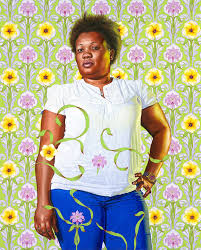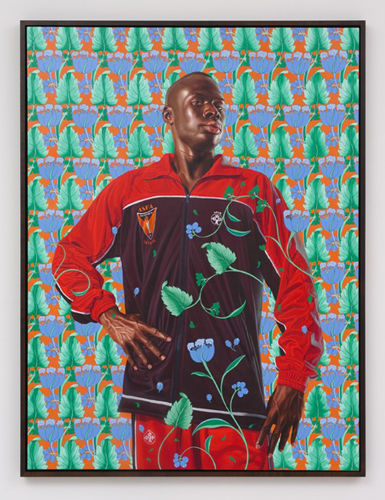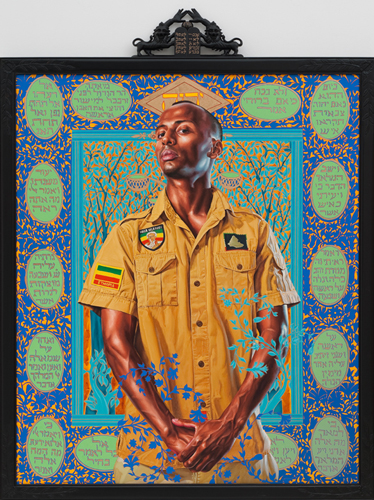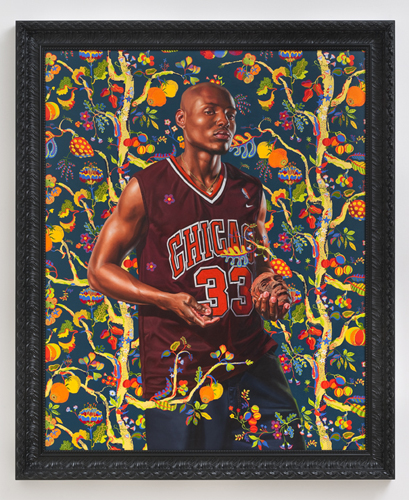
Kehinde Wiley presents his latest works in the ‘world stage series’: HAITI
Roberts & Tilton, 5801 Washington Boulevard, Culver City, CA.
Till October 25.
Venus at Papho (World Stage Series: Haiti), 2014.
About Wiley and his World Stage Series Project:
The Rhetoric of the Heroic and Powerful
 Portrait of Sophia Camy (the World Stage Series: Haiti), 2014.
Portrait of Sophia Camy (the World Stage Series: Haiti), 2014.
In his vast body of work titled The World Stage, Wiley examines a nation’s socioeconomic conditions and culture through the everyday lives of its people, always in the context of the issue of advancing globalization. Past segments of The World Stage have included Jamaica, France, Israel, Brazil, Lagos & Dakar, China, and India/Sri Lanka. The models, dressed in their everyday clothing are asked to appropriate poses found in paintings representative of the history of their surroundings. The portraits are based on well-known images of powerful figures drawn from seventeenth- through nineteenth-century Western art. Wiley engages the visual rhetoric of the heroic, rich, powerful, and majestic, which he attaches to his twenty-first-century subjects and thereby “positions young black men within the field of power.”
 Ferdinand-Philippe-Louis-Henri, Duc of d’Orleans, 2014.
Ferdinand-Philippe-Louis-Henri, Duc of d’Orleans, 2014.
In the minds of the most, Haiti is just another struggling Third World country. Yet, Kehinde Wiley found beauty in Haiti bringing it to the forefront by creating his own beauty pageants, in the long tradition of pageant culture native to the region. In previous World Stage iterations, Wiley conducted his castings on the streets. With The World Stage: Haiti, he made open calls on the radio, posters around the streets, culminating in beauty pageants. Across the Caribbean, pageants serve as mass entertainment events, allowing locals to do more than exhibit poise, talent and physical beauty; pageants are a manifestation of collective cultural values.
 Kalkidan Masasha III (the World Stage Series: Israel), 2013.
Kalkidan Masasha III (the World Stage Series: Israel), 2013.
Haiti’s Colonial Past
Wiley’s pageant winners were chosen randomly rather than through a judging process. In order to deepen the connection between place and era, they were asked to pose as historical sitters from paintings of European masters. Haiti’s colonial past figures strongly in Wiley’s current body of work. He draws from the art history of Spanish and French colonizing powers, summoning parallels across time and geography. Likewise, Haiti’s rich and varied religious traditions, as well as its traditional crafts and decorative arts, inform Wiley’s modern chronicle of life and culture. The backgrounds of the paintings incorporate images of vegetation found on Haiti such as okra, brought first to the island from Africa, and sugarcane, a food product that was broadly exploited as a cash crop during slavery.
 Young Man Holding a Skull, 2013.
Young Man Holding a Skull, 2013.
There is also a documentary film, Kehinde Wiley The World Stage: Haiti that charts the artist’s journey to Jacmel, Jalousie and Port-au-Prince. The film will be screened at Roberts & Tilton during the exhibition. For a preview, check here. The World Stage: Haiti opens on September 13 and will run until October 25.
(from Wide Walls Magazine, September 2014)
Courtesy: Roberts & Tilton Gallery, Curver City.
